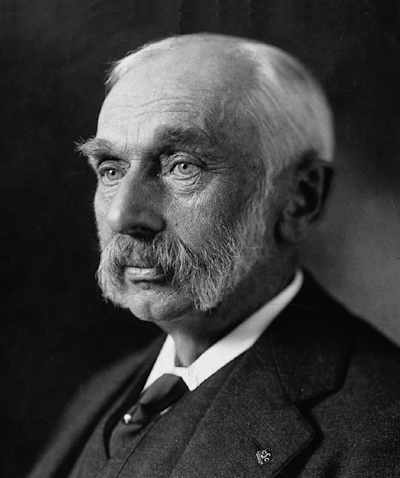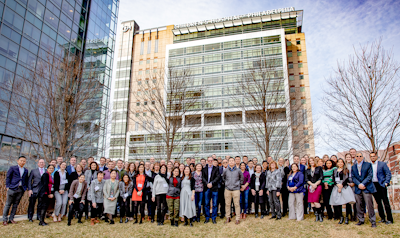Out of the Dark Ages of Pediatric Neuro-Oncology: CBTN's Scientific Co-Chair Editorial in Neoplasia
Posted on
This article originally appeared on Neoplasia - to view the full editorial, visit the link HERE.
Applying collaborative brain power to pull us out of the dark ages of pediatric neuro-oncology
Carl Koschmann & Michael Prados, CBTN Scientific Co-Chairs
To view the list of articles published in Neoplasia, visit the link HERE
The first brain tumor operation known to have taken place was on November 25, 1884 by Dr. Rickman Godlee at the Hospital for Epilepsy and Paralysis in London [1]. A 25-year-old Scottish farm presented with seizures and hemiparesis, that did not respond to treatments with potassium iodide and ice packs. The surgery, which was conducted in “the best antiseptic condition of the time”, did result in removal of a significant portion of the cortical tumor, leaving a cavity “of a size into which a pigeon's egg would fit” [1]. Unfortunately, the patient developed post-operative infection and died 28 days later. In some ways, pediatric neuro-oncology care has made significant strides in the 120 years since this operation. In many other aspects, we are not much better at improving the survival of children and young adults diagnosed with high risk brain tumors.

Pediatric brain tumors are the most common solid tumor of childhood and are now the leading cause of disease-related death in this age group [2]. While other high-risk sub-types of pediatric cancers, such as leukemia and neuroblastoma, have made significant strides in disease-related outcomes, high-risk pediatric brain tumors, including diffuse intrinsic pontine glioma (DIPG), diffuse midline glioma (DMG), posterior fossa ependymoma (PFA), and metastatic medulloblastoma or AT/RT have a median survival of less than two years, which is more or less unchanged since the advent of radiation. With this in mind, the pediatric brain tumor research and clinical community has made a conscious effort within the past two decades to arm themselves with a better understanding of these diseases. With further understanding of the molecular sub-groups and sub-sub groups that underlie these brain tumors, it became apparent that research consortia and clinical trial cooperative groups would be necessary to provide the statistical proof and collaborative brain power to advance discovery.
The Pacific Pediatric Neuro-Oncology Consortium (PNOC) began with a planning meeting in 2012, with the goal to conduct early-phase clinical trials, emphasizing tissue-correlated, precision-based therapeutics.

To a large degree, the reason to begin this consortium was based upon the pressing need for innovative clinical trial development that fully harnessed emerging molecular technologies on behalf of children with the highest unmet needs, and more specifically, the absence of support and funding for tissue-driven approaches for children at that time. PNOC has now grown to include 33 academic centers (in 20 States and Washington, DC) in the United States, and globally includes member institution sites in Switzerland, Australia, New Zealand, Israel, India, and Amsterdam with access to 20 hospitals in those areas. Since its beginning, PNOC has opened or is soon to open over 28 clinical trials, treating over 800 children with these rare diseases.
The Children’s Brain Tumor Network (CBTN) began as a future-changing idea at the Children’s Hospital of Philadelphia (CHOP) in 2011, and more fully launched in 2013 with CHOP as its coordinating center.

The consortium had as its central vision the transformation and acceleration of pediatric brain tumor research through the creation of a comprehensive data-driven centralized biorepository that would allow all researchers across the globe access to deeply clinically annotated biospecimens of children with brain tumors and other rare diseases. Beginning with four academic sites in 2013, it now comprises 34 United States and international sites, with more than 4,900 patients enrolled, >67,000 specimens, 150+ preclinical models, and datasets comprising over 2,500 patient whole genomes (WGS) and RNA-seq analyses, 500+ NCI-funded patient proteomic samples, 2000+ NCI-funded methylation profiles, 2000+ biological parental samples sequenced as well as associated clinical pathology reports, operative reports, radiology reports, scanned histology slides, and radiographic imaging.. Using standard operating procedures (SOPs) and specimen collection kits across sites, a common consent, and a master, multi-institutional data and material transfer agreement, sites collect a prioritized set of fresh-frozen biospecimen and paired blood or saliva, as well as other analytes to be stored in a centrally managed repository located at CHOP. Clinical data are collected longitudinally through common case report forms.

Integrating the efforts of the PNOC clinical trials consortium with the biorepository of CBTN, brings together over 30 major academic institutions working together to support translational research in pediatric Neuro-Oncology. The collaborative work comes about strategically and in a forward-thinking approach via the PNOC/CBTN disease-specific “working groups”, which provide an ongoing source of new ideas, and an environment that fosters support of new, young investigators. Importantly, the structure of the working groups allows direct input by advocacy and philanthropy.
Consequently, clinical trials are being developed based upon new preclinical research activity enhanced by an extensive centralized biorepository with clinically annotated biospecimens, with an NCI-integrated data resource housing the largest molecular/phenotypic pediatric-brain tumor resource, with coordinated, multi-institutional funding from philanthropy. This approach and strategy, to our knowledge, is unique and engages multiple scientists, diverse expertise, and the required resource foundation for accelerated translational research. Rather than an ad hoc single investigator/institution approach, or one based upon the available local resources, the approach is innovative, efficient, and coordinated, first seeking answers to questions within an open science, data- and specimen-informed environment with the expressed intent to improve therapy, and parallel efforts for coordinated funding of ideas that reach consensus priority for clinical development.
In this special issue of Neoplasia, we focus on the current state of translational and clinical research in pediatric Neuro-Oncology, with a special focus on leading international clinicians and researchers working with the Children’s Brain Tumor Network (CBTN), the world’s largest brain tumor biorepository and the Pacific Neuro Oncology Consortium (PNOC). In this series of articles, we will explore the importance of centralized data repositories and consortia and how they can be used to improve outcomes for children with brain tumors. We will discuss the challenges of collecting and analyzing this data, as well as the opportunities it presents for developing personalized treatment approaches and improving our understanding of the biology of pediatric brain tumors [3].
In focusing this issue around the experiences with these data platforms and consortia, we have found unique leverage to reflect on the state of pediatric brain tumor research and clinical care. Experts from working groups within PNOC provide the current and proposed future state of care for DMG [4], ependymoma [5], medulloblastoma [6], AT/RT [7] and low-grade glioma [8], among others. We also learn of current therapeutic and correlate techniques that are currently changing the face of pediatric brain tumor care, including CAR-T [9], CSF biomarkers [10] and advanced metabolic imaging [11]. Waanders et al. provide a unique perspective on how to prioritize the inclusion of Indigenous Peoples in pediatric brain tumor research with cultural sensitivity [12], providing a roadmap that will be useful for clinical research across all disease types and age groups.
These efforts are bringing together researchers, clinicians, and patient advocates to create a shared resource that can benefit children and young adults with brain tumors around the world. Overall, this Special Series will provide an in-depth look at the critical role of pediatric brain tumor data repositories linked with clinical and laboratory researchers, in partnership with advocacy and philanthropy in advancing our understanding and treatment of these devastating and rare diseases.
[1] Kirkpatrick DB (1984). The first primary brain-tumor operation Journal of neurosurgery 61, 809-813.
[2] Ostrom QT, Price M, Ryan K, Edelson J, Neff C, Cioffi G, Waite KA, Kruchko C, Barnholtz-Sloan JS (2022). CBTRUS statistical report: pediatric brain tumor foundation childhood and adolescent primary brain and other central nervous system tumors diagnosed in the United States in 2014–2018 Neuro-oncology 24, iii1-iii38.
[3] Lilly JV, Rokita JL, Mason JL, Patton T, Stefankiewiz S, Higgins D, Trooskin G, Larouci CA, Arya K, Appert E (2023). The children's brain tumor network (CBTN)-Accelerating research in pediatric central nervous system tumors through collaboration and open science Neoplasia 35, 100846.
[4] Coleman C, Chen K, Lu A, Seashore E, Stoller S, Davis T, Braunstein S, Gupta N, Mueller S (2023). Interdisciplinary care of children with diffuse midline glioma Neoplasia 35, 100851.
[5] Hwang EI, Hanson D, Filbin MG, Mack SC (2023). Why haven't we solved intracranial pediatric ependymoma? Current questions and barriers to treatment advances Neoplasia 39, 100895.
[6] Cooney T, Lindsay H, Leary S, Wechsler-Reya R (2023). Current studies and future directions for medulloblastoma: A review from the pacific pediatric neuro-oncology consortium (PNOC) disease working group Neoplasia 35, 100861.
[7] Alva E, Rubens J, Chi S, Rosenberg T, Reddy A, Raabe EH, Margol A (2023). Recent progress and novel approaches to treating atypical teratoid rhabdoid tumor Neoplasia 37, 100880.
[8] Manoharan N, Liu KX, Mueller S, Haas-Kogan DA, Bandopadhayay P (2023). Pediatric low-grade glioma: Targeted therapeutics and clinical trials in the molecular era Neoplasia 36, 100857.
[9] Vitanza NA, Ronsley R, Choe M, Henson C, Breedt M, Barrios-Anderson A, Wein A, Brown C, Beebe A, Kong A (2023). Locoregional CAR T cells for children with CNS tumors: Clinical procedure and catheter safety Neoplasia 36, 100870.
[10] Lehner KR, Jiang K, Rincon-Torroella J, Perera R, Bettegowda C (2023). Cerebrospinal Fluid biomarkers in pediatric brain tumors: A systematic review Neoplasia 35, 100852.
[11] Lovibond S, Gewirtz AN, Pasquini L, Krebs S, Graham MS (2023). The promise of metabolic imaging in diffuse midline glioma Neoplasia 39, 100896.
[12] Waanders A, Brown A, Caron NR, Plisiewicz A, McHugh ST, Nguyen TQ, Lehmann K, Stevens J, Storm PJ, Resnick A (2023). Indigenous peoples and inclusion in clinical and genomic research: Understanding the history and navigating contemporary engagement Neoplasia 37, 100879.